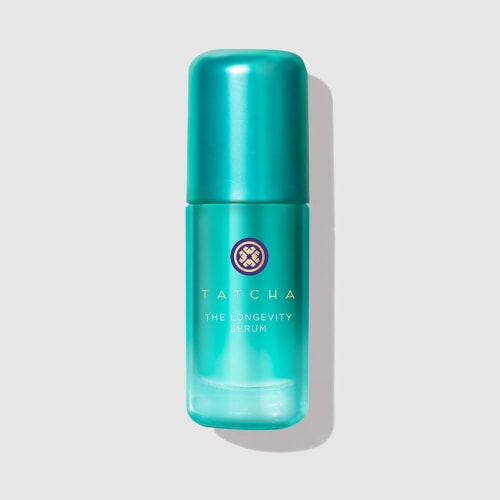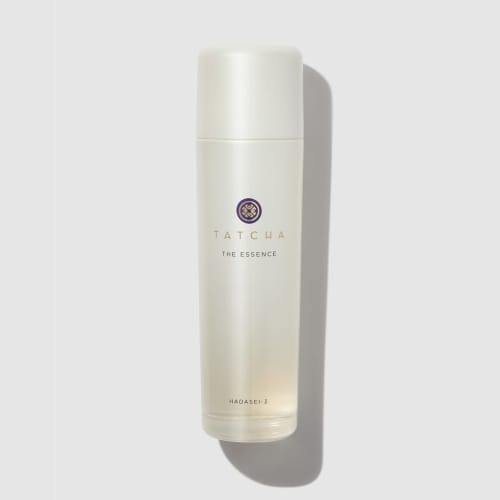Summary:
- Cellular senescence is a natural biological process in which damaged cells stop replicating but still carry out their cellular functions.
- As we age–and environmental and lifestyle factors take their toll–we produce an increasing number of senescent cells that our bodies are unable to clear.
- These senescent cells can lead to unnecessary aging, dryness, irritation, fine lines, and more.
- The rapid accumulation of senescent cells can be slowed with a few key habits, including daily sunscreen use, a healthy diet, and skincare geared towards their reduction.
Aging is normal, but accelerated aging is not. The first signs of aging occur through a process called cellular senescence, which can exacerbate dryness, irritation, and fine lines. But there is a solution–keep reading to find out more.

At Tatcha, we’ve always believed that aging is a gift. But that doesn’t mean you can’t do anything about it, particularly when it comes to unnatural and accelerated aging. The reasons and causes behind how our bodies and skin age are complex and complicated, but one of the first markers is cellular senescence. What is cellular senescence, and what can you do about it? We dive into these topics and more below.
What is Cellular Senescence? Cellular senescence is a wordy phrase, a heady scientific concept, and an implication of unnatural aging — yikes! But it doesn’t have to be confusing. Cellular senescence is simply a marker of aging. The process is happening constantly in our bodies.
In youth, our cells effectively remove senescent cells to make room for new, healthy cells. However, as we age (and environmental and lifestyle factors come into play), we produce more senescent cells, and our bodies are unable to clear the increasing number. This accumulation results in issues in our bodies and skin. These senescent cells also cause a chain reaction.
After all, another common way to reference this scientific reaction is senescent or “zombie” cells. These cells have been damaged as a result of several factors, like pollution, age, or lifestyle choices. Repeated exposure to these numerous factors causes the cells to malfunction, resulting in them failing to replicate as they should, creating an inflammatory response. This is bad enough, but the next reaction is where they get the “zombie” nickname. They then start accumulating and secreting inflammatory molecules that can cause healthy cells around them to become senescent too. This horror-movie-like troupe makes neighboring healthy cells begin to age faster, causing a vicious cycle of chronic, low-grade inflammation called inflammaging.
Cellular Senescence and Aging Skin
Cellular senescence plays a major role in aging and skin longevity (a movement focused on the root causes of aging and how to maintain the structure and function of skin, too). Basically, the more senescent cells you have, the older your skin acts, which translates to thinner skin, dryness, a loss of firmness and elasticity, weakening of the skin barrier, and accelerated aging. The weakening of the skin barrier, a protective shield that keeps skin well, is particularly damaging. Inflammaging occurs much quicker when the barrier is damaged, allowing these issues to hit the fast lane on the skin aging highway.
As we mentioned above, there are many causes of senescence in the skin, but here are a few of the most common.
Chronological vs. Biological Aging
As we age, we naturally increase the number of senescent cells in our bodies, due in part to what one study calls “DNA damage.” This is perfectly normal and part of aging because chronological aging is simply your age. Alternatively, accelerated or biological aging refers to the functional and physiological state of the body, which can differ from your chronological age due to lifestyle factors, genetics, and more.
Excessive Sun Exposure
UVA and UVB rays cause DNA damage, notes a 2023 study. This DNA damage can result in senescence and premature skin aging. However, long-term exposure to UV rays can increase the risk of developing skin cancers.
Pollution
Does pollution really damage the skin? Yes, says that same 2023 study, noting that “pollution contains a multitude of components that exert different effects on the skin.”
Everything from hyperpigmentation, accelerated aging, atopic dermatitis, and acne can be linked to pollution. Each form of pollution can target skin in differing ways, but the basis is skin inflammation, which causes skin to rapidly alter and age faster than it normally would.
Cellular Senescence: The Good News
Why do our bodies even tolerate zombie cells? It stems from a protective intention, evolved to prevent damaged cells from replicating, which prevents tumor growth, scarring in organs, and chronic inflammation that accelerates visible skin aging. By turning off damaged cells, the body prevents these potentially dangerous effects from spreading.
How to Reduce Cellular Senescence in Skin
It’s not all bad news for our skin, either. Unlike many other biological processes that occur in the body, cellular senescence can actually be slowed and, in some instances, even reversed. There is promising research that shows senescent cells can be not only reduced, but also the renewal of healthy cells in their place is possible. What brings upon these positive changes? Lifestyle changes, of course, including avoiding excessive sun exposure, wearing sunscreen daily, prioritizing sleep, reducing stress, and eating a healthy diet. Also, surprisingly, skincare–especially when it’s part of a complete healthy aging routine–is geared towards targeting senescent cells.
Introducing The Longevity Serum
Skincare that targets senescent cells? Well, that just so happens to be the exact focus of Tatcha’s brand-new Longevity Serum.
It’s inspired by the Japanese islands of Okinawa, which have long been known as the Land of Immortals and are home to some of the world’s longest-living women. In addition to an active lifestyle and a deeply connected community, a key factor that keeps them energized and vibrant is their plant-forward diet, based on nuchi-gusui, nutrient-rich wild herbs and plants used for centuries to promote health. The people and spirit of these islands inspired Tatcha’s new Longevity Serum, created to extend your skin’s prime years.
Targeting senescent cells, The Longevity Serum not only reduces this cellular slowdown, but it also supports healthy cell turnover to help delay future signs of aging as well. Infused with the Okinawa Cellescence Complex, the serum delivers a visibly firmer, smoother, and more collagen-rich appearance. This complex uses heralded Okinawan botanicals, including shikuwasa lime, noni juice, and shell ginger extracts, to reduce inflammaging and proactively defend the skin from future signs of aging. The serum also includes bio-active lipids to calm oxidative stress and support natural collagen and elastin, plus prebiotics to nourish the skin’s microbiome. In clinical studies, 100 percent of participants showed visibly firmer, smoother skin in just one week* and senescent cell markers were reduced by 55 percent.**
At Tatcha, we’ve always believed in helping you uncover skin that is as strong as you are. Now, with the Longevity Serum, we can help you also achieve skin that looks as vibrant as you feel.
Senescence-Slowing Skincare Routine
Products are wonderfully effective on their own, but if they are not part of a larger, holistic skincare routine, they will have a more difficult time accomplishing their proven results. A senescence-slowing skincare routine would look something like this for both morning and night:
1. Purify
Select your facial cleanser of your choice. To help narrow down the choices, select by your face type.
2. Polish
Follow up with The Rice Polish, which contains both gentle chemical and physical exfoliants (via rice bran) for a lustrous feel and look. Just as is the case with facial cleansers, our Rice Polishes are customized to skin type, so find the one that fits you specifically.
3. Plump
Soften, firm, and hydrate with The Essence, a multitasking elixir that improves the effectiveness of your other skincare.
4. Treat
This is where your Longevity Serum steps in to save the day (and your skin). Massage in one to two pumps both morning and/or night for all the ultimate skin-longevity benefits.
5. Nourish
Follow up with a moisturizer to lock in those impressive results. As with many things at Tatcha, our moisturizers are perfected by skin type, so discover which formula(s) are right for you by narrowing down your specific needs.
*Based on a clinical study of 39 panelists.
**Disclaimer: In vitro testing stress-induced senescent cell biomarkers.
Frequently Asked Questions
Many products that focus on aging tend to zero in on superficial things, like fine lines and wrinkles, while The Longevity Serum targets the root issue of accelerated aging, like senescent cells. This makes the formula more beneficial in the long run, helping to address the long-term causes of aging versus targeting the aftereffects of it.
Inflammaging is reversible — if it doesn’t become chronic and the cells are addressed early enough. Studies suggest that senescence evolves, first from a temporary or reversible stage to a chronic and irreversible issue if conditions remain or increase. Lifestyle choices and skincare products (like The Longevity Serum) can help address senescent cells.
You can, The Longevity Serum plays well with other serums. So each formula can get some solo time, perhaps separate the formulas between day and night. For example, apply The Longevity Serum in the morning and The Silk Serum or The Brightening Serum at night.
Many ‘anti-aging’ formulas rely on harsh formulas, like retinol, to power their results. While it’s a potent and proven product, it’s not for everyone, and those with sensitive skin can have an especially difficult time trying to use healthy-aging products. Like all of our formulas, The Longevity Serum was developed with sensitive skin in mind.



